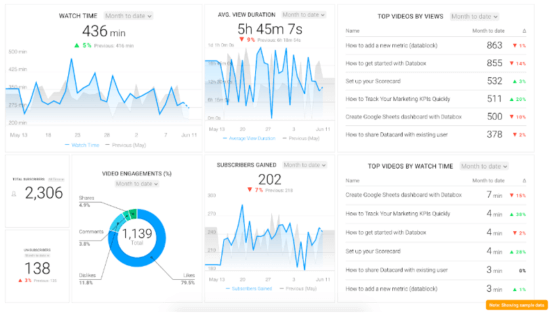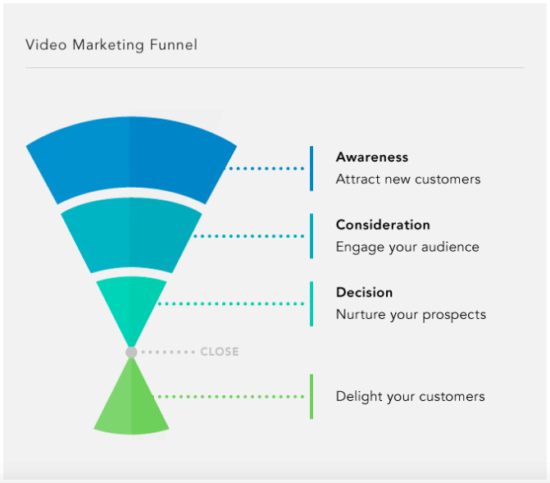Nobody can deny that the rise of video has drastically changed the way we consume content.
Video allows customers today to get all the information they need about your brand in a matter of minutes, with as little resistance as possible. Importantly, brands using video can engage customers more intimately than ever before.
Statistics about video marketing that will blow your mind
- A study conducted by Hubspot showed that 78% of people watch videos every week, while 55% of people watch videos daily.
- Hubspot found that 72% of customers want to learn about brands through video and 85% of businesses now use videos as a marketing tool.
- Cisco predicts that in 2020, there will be close to 1 million minutes of videos uploaded to the internet per second.
- Google states that out of ten people, six would rather watch videos online than television.

Your video marketing strategy in 2020 needs to be defined
With such fast-paced growth, how does your video marketing strategy make you can stand out from the crowd and increase the view rate of your videos? Today, take a step back and consider these five simple truths for your video marketing strategy.
1. If you try to market to everyone, you ultimately market to no one
Everyone wants to create a ‘viral’ video. But, that’s just social proof. When it comes to brands, your video marketing strategy needs to cater to the marketing goals you want to achieve. These goals could include:
- Increase brand awareness
- Increase sales and revenue
- Get leads
- Increase traffic.
These goals can only be achieved if you can identify who you want to market to exactly. You need to have a clear understanding of what your audience wants and expects. To create a video that reaches your target audience, you need to determine a couple of things like:
- The channels they use to watch videos
- The language they are most frequent in
- What challenges they face, for which you could provide a solution
Once you understand where they are, what motivates them, what aspirations they have, you will be able to create a video that instantly connects with them in a meaningful way.
Download our Individual Member Resource – Video and YouTube marketing guide
Our guide to video marketing will help you grow your business online using video. Members can review a range of opportunities for video - forming a strategy for video within wider marketing activity, as well as planning the practical steps to success within this fast-growing medium.
Access the Video and YouTube marketing guide
2. One type of video doesn’t fit all
Now that you know who you are creating the video for, you need to determine what type of video to create. Different audiences prefer to consume videos in various formats. Here is a list of the most popular types of videos brands use to market themselves:
Demo videos
Arguably, these are the most popular type of videos used by brands to showcase their products or services. Through these videos, you can take your viewers on a tour of how your product works or how effective your service is in action.
Brand videos
Part of an advertiser campaign, brand videos are used to tell the viewers the story of your brand, vision, mission, and plans. The goal of this type of video is to increase awareness and form a connection with the audience.
Event videos
If your company is hosting a fundraiser or a conference, an event video is the best way to raise maximum traction about the upcoming event. You can showcase a highlight reel or give teasers of what to expect to build curiosity among the viewers.
How-to videos
Viewers are on the constant lookout for information. Brands can impress viewers by helping them solve a problem through how-to or instructional videos. These videos can present your product or service as a solution to common issues faced by viewers.
360° and virtual reality videos
Technology advancements have always been the best way to capture a viewer’s attention. The latest trend is all about 360° videos, wherein people can “scroll” around to see the content from every angle. Virtual reality (VR) videos allow users to navigate and control their viewing experience. These videos aim to make the viewer feel like they are present at the location.
3. Don’t forget; you’re here to market YOUR brand
Regardless of the type of video you decide to create, you need to remain consistent with your branding. Videos are a great way to spread brand awareness, and regardless if a viewer purchases your offerings or not, you need to ensure they retain brand recognition.
By maintaining consistent branding, you will be able to instill a sense of professionalism which will, over time, lead to trust. To do this you need to integrate certain branding elements in the videos you publish - so your customers recognize your content whenever they see it. It doesn’t have to be a logo integration of even something in the video; it can simply be a unique item of clothing you wear when recording or the inclusion of a short intro or outro on each video.
4. Short and simple always works wonders
Videos are popular because they are easy to consume. The longer the video, the higher the risk of the viewers leaving the video midway. Hence, your video script needs to be short and simple. For example, a 350-word script usually equates to 2 minutes, which is plenty in the video world.
Yes, just 350 words are more than enough. Videos work differently to articles. When writing the script, you may feel like you aren’t saying enough, but when the same is read aloud, you’ll realize that you’ve said more than enough. Here’s an example of how articles and video scripts should differ:
Article version: When a person tags you in a photo on Instagram, it’s automatically added to your profile under “Photos of You.” You can turn this off by opting to add tagged photos manually. To see the images that you have been tagged in, you need to go to your profile and click the person icon, which is located below your bio.
Video script version: To access the photos have you been tagged in, simply click on the “Photos of You” tab on your profile right there. You can shut off with this button and choose photos manually instead.
As given in the example above, articles need to use more words to explain all the details as the reader is just relying on the text to understand the context. However, in the video script, the viewers can listen to the presenter while they point to visuals that show them what needs to be done.
5. If you aren’t tracking, you aren’t succeeding
So, now you know who you are marketing to, what you are creating, and how long should it be. Time to get started, right? Not yet.
Before you start video marketing, you need to have your goals defined clearly. At this stage, select the specific metrics that will help you determine if you have accomplished your goals or not. This will help you measure the ROI of the content you publish.
Here are some of the most common and effective types of metrics you could choose from:

[Image Source]
- View count
- Play rate
- Social sharing and comments
- Video completions
- Click-through rate
- Conversion rate
- Bounce rate and time-on-page

Ready, set, action!
With the magnitude of tools and apps available, creating and marketing video content has never been easier. Just remember to invest time, effort, and a great marketing strategy, and you will surely succeed in this endeavor!
Arvind Patil is an SEO and Content Strategist at
SRV Media, a digital agency. He loves to create a content strategy that connects brands with their target audience. When he is not busy analyzing digital market trends, he is traveling.





















